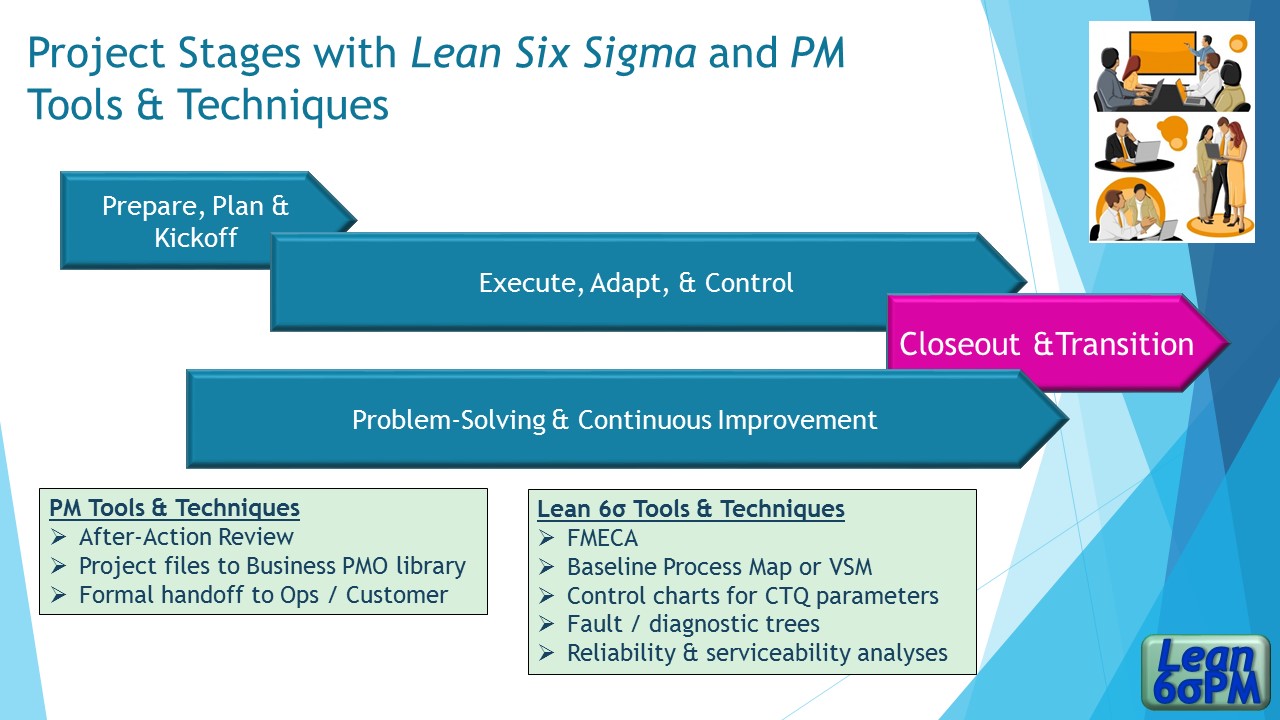Project Closeout and Transition to Your Customer

Tips for a successful project closeout
As your project is nearing the final milestones before completion, begin taking the steps necessary for an orderly transition to its ultimate operational environment. Your effectiveness in project closeout conveys your level of professionalism as a PM to your entire business organization.
If your business makes use of a standard checklist for project closeout, arrange to spend some time with your project’s customer (internal or external) to review the items on that checklist, adding or modifying tasks, and ensuring agreement on who does what in transition. If there is no standard checklist, create one with your customer so that terms of agreement are clearly documented.
You have been publishing and storing many detailed documents in a project shared file throughout the project duration. A key part of closeout is to ensure that the project file is complete and properly archived for future reference.
Before your team members move on to new programs, plan and conduct a thorough After Action Review (AAR) to capture the technical and organizational learning that occurred during the project. Consider problems that arose, review how they were addressed and resolved, and how they might be prevented in future similar programs. Unexpected successes and opportunities that your team capitalized on are important, too, because those experiences often have a profound effect on project results. Assess and critique your team performance, with particular emphasis on personal and professional growth observed for leaders and junior members, and consider what follow-on experiences would be beneficial for team members.
The Sharpen Your Saw post, “Conducting an Effective After Action Review” provides several tips for this important activity.
Make sure the recipients (customers, users) of your completed project are fully trained and prepared to maximize the value of the deliverables you have taken from idea to reality.
And remember to celebrate your team’s accomplishment with something more than simply turning out the conference room lights one last time. Your team will likely disband, but the world is small and many of you will work together again soon, so finish the project in an uplifting and memorable way!
As your project is nearing the final milestones before completion, begin taking the steps necessary for an orderly transition to its ultimate operational environment. Your effectiveness in project closeout conveys your level of professionalism as a PM to your entire business organization.
If your business makes use of a standard checklist for project closeout, arrange to spend some time with your project’s customer (internal or external) to review the items on that checklist, adding or modifying tasks, and ensuring agreement on who does what in transition. If there is no standard checklist, create one with your customer so that terms of agreement are clearly documented.
You have been publishing and storing many detailed documents in a project shared file throughout the project duration. A key part of closeout is to ensure that the project file is complete and properly archived for future reference.
Before your team members move on to new programs, plan and conduct a thorough After Action Review (AAR) to capture the technical and organizational learning that occurred during the project. Consider problems that arose, review how they were addressed and resolved, and how they might be prevented in future similar programs. Unexpected successes and opportunities that your team capitalized on are important, too, because those experiences often have a profound effect on project results. Assess and critique your team performance, with particular emphasis on personal and professional growth observed for leaders and junior members, and consider what follow-on experiences would be beneficial for team members.
The Sharpen Your Saw post, “Conducting an Effective After Action Review” provides several tips for this important activity.
Make sure the recipients (customers, users) of your completed project are fully trained and prepared to maximize the value of the deliverables you have taken from idea to reality.
And remember to celebrate your team’s accomplishment with something more than simply turning out the conference room lights one last time. Your team will likely disband, but the world is small and many of you will work together again soon, so finish the project in an uplifting and memorable way!
When it's time to take Action --

This final project phase is referred to here as “Project Closeout and Transition” because the completion of the project effort is accompanied by a handoff to someone else, who will assume responsibility for ongoing operation or transactions using the output of the project (new product, design improvement, new equipment, new factory, etc.).
A well-run project includes completion of information, documentation, procedures, and support so that the recipient (customer or business unit) can make most effective use of the output.
To take one example, a new product development project goes through several design reviews, design verification tests, and validation testing of the design outputs against the documented user needs. The technical protocols for these reviews and tests, plus the test results including analysis of failures and anomalies, are surely part of the design file.
This level of focused attention is sufficient for most project managers to successfully close out the project.
Go for Extraordinary!
Successful closeout is good enough for 85-90% of PM’s and their executive leadership.
Exceptional project leaders, the top 10% or so who refuse to settle for good enough, recognize their ownership of some additional steps to transition the project to Operations.
In connection with the reviews and qualification tests during the project, the product development PM and team will collaborate with the Operations team or external manufacturer receiving the product, to ensure that Manufacturing has a repeatable process and can scale up to meet projected demand throughout product life.
Cross-functional collaboration makes use of Lean Six Sigma (LSS) tools to produce support documentation, such as:
♦ Design and Process FMECAs
♦ A baseline Process Map or Value Stream Map
♦ Control charts for Critical to Quality (CTQ) parameters
♦ Fault and diagnostic trees (baseline)
♦ Reliability and Serviceability analyses
For projects other than new product development, similar activities are needed, with project output documents, initial training, and plans for ongoing support determined by the needs of the customer or organizational recipient.
If your business unit’s Quality organization has one or more Black Belt LSS practitioners, one of the Black Belts should be brought into the project as an adjunct resource at the time you, the PM, begin to anticipate the Closeout and Transition Stage, in order to preclude any delay of the eventual handoff, or the need for continuation support from the development team.
No LSS Black Belts on staff? Ping me at Dann@Lean6SigmaPM.com, to discuss how to fulfill the requirements of that role in a timely and cost-effective manner, to ensure your project Closeout and Transition are professionally handled, to the delight of your internal or external customers.
Successful closeout is good enough for 85-90% of PM’s and their executive leadership.
Exceptional project leaders, the top 10% or so who refuse to settle for good enough, recognize their ownership of some additional steps to transition the project to Operations.
In connection with the reviews and qualification tests during the project, the product development PM and team will collaborate with the Operations team or external manufacturer receiving the product, to ensure that Manufacturing has a repeatable process and can scale up to meet projected demand throughout product life.
Cross-functional collaboration makes use of Lean Six Sigma (LSS) tools to produce support documentation, such as:
♦ Design and Process FMECAs
♦ A baseline Process Map or Value Stream Map
♦ Control charts for Critical to Quality (CTQ) parameters
♦ Fault and diagnostic trees (baseline)
♦ Reliability and Serviceability analyses
For projects other than new product development, similar activities are needed, with project output documents, initial training, and plans for ongoing support determined by the needs of the customer or organizational recipient.
If your business unit’s Quality organization has one or more Black Belt LSS practitioners, one of the Black Belts should be brought into the project as an adjunct resource at the time you, the PM, begin to anticipate the Closeout and Transition Stage, in order to preclude any delay of the eventual handoff, or the need for continuation support from the development team.
No LSS Black Belts on staff? Ping me at Dann@Lean6SigmaPM.com, to discuss how to fulfill the requirements of that role in a timely and cost-effective manner, to ensure your project Closeout and Transition are professionally handled, to the delight of your internal or external customers.
